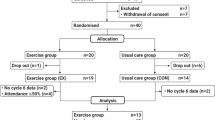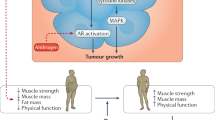Abstract
Purpose
Although skeletal muscle releases cytokines called myokines during exercise, the kinetics of the acute myokine response to exercise (exercise-induced circulatory myokine level alteration) is unknown in patients with advanced prostate cancer. We measured myokine levels in serum obtained from patients with metastatic castrate-resistant prostate cancer (mCRPC) before and after exercise and assessed the growth-suppressive effect of the serum by applying it to a PCa cell line.
Methods
Nine patients with mCRPC (age = 67.8 ± 10.1 years, time since mCRPC diagnosis 36.2 ± 22.5 months) undertook 34 min of a high-intensity interval exercise session on a cycle ergometer. Blood was collected immediately pre, post and 30 min post. Serum levels of secreted protein acidic and rich in cysteine (SPARC), oncostatin M (OSM), interleukin-6 (IL-6), interleukin-15 (IL-15), decorin, irisin, and IGF-1 were determined. Growth of the androgen-independent PCa cell line DU-145 exposed to serum collected at three points was measured.
Results
There was a significant elevation of SPARC (19.9%, P = 0.048), OSM (11.5%, P = 0.001), IL-6 (10.2%, P = 0.02) and IL-15 (7.8%, P = 0.023) in serum collected immediately after exercise compared to baseline, returning to baseline after 30 min rest. A significant reduction in DU-145 Cell growth and the Cell Index area under the curve at 72 h incubation was observed with the presence of serum obtained immediately post-exercise (Cell Index at 72 h: 16.9%, P < 0.001; area under the curve: 15.2%, P < 0.001) and with the presence of serum obtained 30 min post-exercise compared to baseline (Cell Index at 72 h: 6.5%; area under the curve: 8.8%, P < 0.001).
Conclusion
This study provides preliminary evidence for an acute exercise-induced myokine response and tumour growth suppression in serum after a bout of high-intensity interval exercise in patients with advanced PCa.
This is a preview of subscription content, access via your institution
Access options
Subscribe to this journal
Receive 4 print issues and online access
$259.00 per year
only $64.75 per issue
Buy this article
- Purchase on Springer Link
- Instant access to full article PDF
Prices may be subject to local taxes which are calculated during checkout




Similar content being viewed by others
Data availability
The data are available for bona fide researchers who request it from the authors.
References
Schmitz KH, Campbell AM, Stuiver MM, Pinto BM, Schwartz AL, Morris GS, et al. Exercise is medicine in oncology: Engaging clinicians to help patients move through cancer. CA Cancer J Clin. 2019;69:468–84.
Galvao DA, Taaffe DR, Spry N, Cormie P, Joseph D, Chambers SK, et al. Exercise preserves physical function in prostate cancer patients with bone metastases. Med Sci Sports Exerc. 2018;50:393–9.
Galvão DA, Taaffe DR, Spry N, Joseph D, Newton RU. Combined resistance and aerobic exercise program reverses muscle loss in men undergoing androgen suppression therapy for prostate cancer without bone metastases: A randomized controlled trial. J Clin Oncol. 2010;28:340–7.
Lopez P, Taaffe DR, Newton RU, Galvao DA. Resistance exercise dosage in men with prostate cancer: Systematic review, meta-analysis, and meta-regression. Med Sci Sports Exerc. 2020;53:459–69.
Kenfield SA, Stampfer MJ, Giovannucci E, Chan JM. Physical activity and survival after prostate cancer diagnosis in the health professionals follow-up study. J Clin Oncol. 2011;29:726–32.
Richman EL, Kenfield SA, Stampfer MJ, Paciorek A, Carroll PR, Chan JM. Physical activity after diagnosis and risk of prostate cancer progression: data from the cancer of the prostate strategic urologic research endeavor. Cancer Res. 2011;71:3889–95.
Dethlefsen C, Hansen LS, Lillelund C, Andersen C, Gehl J, Christensen JF, et al. Exercise-induced catecholamines activate the hippo tumor suppressor pathway to reduce risks of breast cancer development. Cancer Res. 2017;77:4894–904.
Dethlefsen C, Lillelund C, Midtgaard J, Andersen C, Pedersen BK, Christensen JF, et al. Exercise regulates breast cancer cell viability: systemic training adaptations versus acute exercise responses. Breast Cancer Res Treat. 2016;159:469–479.
Devin JL, Hill MM, Mourtzakis M, Quadrilatero J, Jenkins DG, Skinner TL. Acute high intensity interval exercise reduces colon cancer cell growth. J Physiol. 2019;597:2177–84.
Hwang JH, McGovern J, Minett GM, Della Gatta PA, Roberts L, Harris JM, et al. Mobilizing serum factors and immune cells through exercise to counteract age-related changes in cancer risk. Exerc Immunol Rev. 2020;26:80–99.
Rundqvist H, Augsten M, Stromberg A, Rullman E, Mijwel S, Kharaziha P, et al. Effect of acute exercise on prostate cancer cell growth. PLoS ONE. 2013;8:e67579.
Fiuza-Luces C, Garatachea N, Berger NA, Lucia A. Exercise is the real polypill. Physiol (Bethesda). 2013;28:330–58.
Pedersen BK. The Physiology of optimizing health with a focus on exercise as medicine. Annu Rev Physiol. 2019;81:607–27.
Kim J-S, Galvão DA, Newton RU, Gray E, Taaffe DR. Exercise-induced myokines and their effect on prostate cancer. Nat Rev Urol. 2021;18:519–42.
Shin M, Mizokami A, Kim J, Ofude M, Konaka H, Kadono Y, et al. Exogenous SPARC suppresses proliferation and migration of prostate cancer by interacting with integrin β1. Prostate. 2013;73:1159–70.
Tekin S, Erden Y, Sandal S, Yilmaz B. Is irisin an anticarcinogenic peptide? Med-Sci. 2015;4:2172–80.
Hu Y, Sun H, Owens RT, Wu J, Chen YQ, Berquin IM, et al. Decorin suppresses prostate tumor growth through inhibition of epidermal growth factor and androgen receptor pathways. Neoplasia. 2009;11:1042–53.
Saylor PJ, Smith MR. Adverse effects of androgen deprivation therapy: Defining the problem and promoting health among men with prostate cancer. J Natl Compr Canc Netw. 2010;8:211–23.
Reisz-Porszasz S, Bhasin S, Artaza JN, Shen R, Sinha-Hikim I, Hogue A, et al. Lower skeletal muscle mass in male transgenic mice with muscle-specific overexpression of myostatin. Am J Physiol Endocrinol Metab. 2003;285:E876–888.
Singh R, Bhasin S, Braga M, Artaza JN, Pervin S, Taylor WE, et al. Regulation of myogenic differentiation by androgens: cross talk between androgen receptor/ beta-catenin and follistatin/transforming growth factor-beta signaling pathways. Endocrinology. 2009;150:1259–68.
Kim JS, Taaffe DR, Galvão DA, Hart NH, Gray E, Ryan CJ, et al. Exercise in advanced prostate cancer elevates myokine levels and suppresses in-vitro cell growth. Prostate Cancer Prostatic Dis. 2022;25:86–92.
Kim JS, Wilson RL, Taaffe DR, Galvao DA, Gray E, Newton RU. Myokine expression and tumor-suppressive effect of serum following 12 weeks of exercise in prostate cancer patients on ADT. Med Sci Sports Exerc. 2021;54:197–205.
Newton RU, Kenfield SA, Hart NH, Chan JM, Courneya KS, Catto J, et al. Intense exercise for survival among men with metastatic castrate-resistant prostate cancer (INTERVAL-GAP4): A multicentre, randomised, controlled phase III study protocol. BMJ Open. 2018;8:e022899.
Febbraio MA, Ott P, Nielsen HB, Steensberg A, Keller C, Krustrup P, et al. Hepatosplanchnic clearance of interleukin-6 in humans during exercise. Am J Physiol Endocrinol Metab. 2003;285:E397–402.
Hiscock N, Chan MH, Bisucci T, Darby IA, Febbraio MA. Skeletal myocytes are a source of interleukin-6 mRNA expression and protein release during contraction: evidence of fiber type specificity. FASEB J. 2004;18:992–4.
Keller C, Steensberg A, Pilegaard H, Osada T, Saltin B, Pedersen BK, et al. Transcriptional activation of the IL-6 gene in human contracting skeletal muscle: influence of muscle glycogen content. FASEB J. 2001;15:2748–50.
Hojman P, Dethlefsen C, Brandt C, Hansen J, Pedersen L, Pedersen BK. Exercise-induced muscle-derived cytokines inhibit mammary cancer cell growth. Am J Physiol Endocrinol Metab. 2011;301:E504–510.
Aoi W, Naito Y, Takagi T, Tanimura Y, Takanami Y, Kawai Y, et al. A novel myokine, secreted protein acidic and rich in cysteine (SPARC), suppresses colon tumorigenesis via regular exercise. Gut. 2013;62:882–9.
Nielsen AR, Mounier R, Plomgaard P, Mortensen OH, Penkowa M, Speerschneider T, et al. Expression of interleukin-15 in human skeletal muscle effect of exercise and muscle fibre type composition. J Physiol. 2007;584:305–12.
Perez-Lopez A, McKendry J, Martin-Rincon M, Morales-Alamo D, Perez-Kohler B, Valades D, et al. Skeletal muscle IL-15/IL-15Ralpha and myofibrillar protein synthesis after resistance exercise. Scand J Med Sci Sports. 2019;28:116–25.
Pierce JR, Maples JM, Hickner RC. IL-15 concentrations in skeletal muscle and subcutaneous adipose tissue in lean and obese humans: local effects of IL-15 on adipose tissue lipolysis. Am J Physiol Endocrinol Metab. 2015;308:E1131–1139.
Heinemeier KM, Bjerrum SS, Schjerling P, Kjaer M. Expression of extracellular matrix components and related growth factors in human tendon and muscle after acute exercise. Scand J Med Sci Sports. 2013;23:e150–161.
Kanzleiter T, Rath M, Gorgens SW, Jensen J, Tangen DS, Kolnes AJ, et al. The myokine decorin is regulated by contraction and involved in muscle hypertrophy. Biochem Biophys Res Commun. 2014;450:1089–94.
Loffler D, Muller U, Scheuermann K, Friebe D, Gesing J, Bielitz J, et al. Serum irisin levels are regulated by acute strenuous exercise. J Clin Endocrinol Metabo. 2015;100:1289–99.
Tsuchiya Y, Ando D, Takamatsu K, Goto K. Resistance exercise induces a greater irisin response than endurance exercise. Metabolism. 2015;64:1042–50.
Morgan AK, Shore N, Cope D, McNatty A, Moslehi J, Gomella L, et al. Androgen receptor inhibitor treatment: Cardiovascular adverse events and comorbidity considerations in patients with non-metastatic prostate cancer. Urol Oncol. 2021;39:52–62.
Acknowledgements
The authors thank Harry Perkins Institute, Nedlands, WA, Australia, for providing prostate cancer cell line DU145.
Funding
This work was funded by the Movember Foundation. National Health and Medical Research Council Centre of Research Excellence (NHMRC-CRE; APP1116334) funded the additional materials involving serum analysis and cell work through Centre for Research Excellence in Prostate Cancer Survivorship. J-SK is supported by the NHMRC Centre for Research Excellence in Prostate Cancer Survivorship Scholarship.
Author information
Authors and Affiliations
Contributions
J-SK and RU Newton had full access to all the data in the study and take responsibility for the integrity of the data and accuracy of the data analysis. J-SK, RUN, DRT and DAG conceptualised the study. J-SK and RUN designed the study. RUN, J-SK, DAG and NHH collected the clinical information, body composition and fasting blood samples. NHH and SAK supervised and directed the overall study’s implementation, data collection, and data monitoring. J-SK analysed the data. J-SK and RUN were responsible for the drafting of the paper. RUN, DRT, DAG, TDC, ADR, EG, CJC, SAK and FS provided administrative, technical, intellectual and material support. J-SK, RUN, DRT, DAG, TC, ADR, NHH, ESG, CJR, SAK and FS reviewed and edited the paper prior to submission.
Corresponding author
Ethics declarations
Competing interests
The authors declare no competing interests. Sponsors had no role in the design of the study; the collection, analysis, and interpretation of the data; the writing of the paper; and the decision to submit the paper for publication.
Ethics approval and consent to participate
The study was conducted according to the guidelines of the Declaration of Helsinki and approved by the Edith Cowan University Human Research Ethics Committee (ID: 13236 NEWTON). Informed consent was obtained from all subjects involved in the study prior to inclusion.
Additional information
Publisher’s note Springer Nature remains neutral with regard to jurisdictional claims in published maps and institutional affiliations.
Rights and permissions
Springer Nature or its licensor (e.g. a society or other partner) holds exclusive rights to this article under a publishing agreement with the author(s) or other rightsholder(s); author self-archiving of the accepted manuscript version of this article is solely governed by the terms of such publishing agreement and applicable law.
About this article
Cite this article
Kim, JS., Taaffe, D.R., Galvão, D.A. et al. Acute effect of high-intensity interval aerobic exercise on serum myokine levels and resulting tumour-suppressive effect in trained patients with advanced prostate cancer. Prostate Cancer Prostatic Dis 26, 795–801 (2023). https://doi.org/10.1038/s41391-022-00624-4
Received:
Revised:
Accepted:
Published:
Issue Date:
DOI: https://doi.org/10.1038/s41391-022-00624-4
This article is cited by
-
Cardiovascular adverse events-related to GnRH agonists and GnRH antagonists: analysis of real-life data from Eudra-Vigilance and Food and Drug Administration databases entries
Prostate Cancer and Prostatic Diseases (2023)
-
Can high-intensity interval training impact tumor suppression and inflammatory response in prostate cancer survivors?
Prostate Cancer and Prostatic Diseases (2023)
-
Tumour-suppressing HIIT serum
Nature Reviews Urology (2023)
-
Exercise and the gut microbiome: implications for supportive care in cancer
Supportive Care in Cancer (2023)



